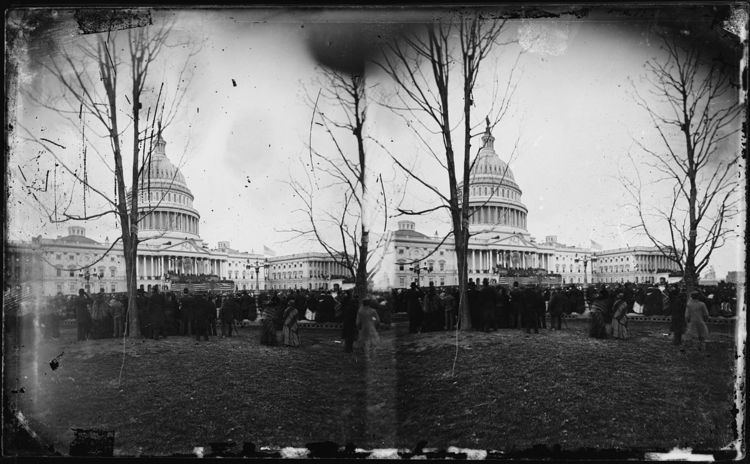The Forty-first United States Congress was a meeting of the legislative branch of the United States federal government, consisting of the United States Senate and the United States House of Representatives. It met in Washington, D.C. from March 4, 1869 to March 4, 1871, during the first two years of Ulysses Grant's presidency. The apportionment of seats in the House of Representatives was based on the Eighth Census of the United States in 1860. Both chambers had a Republican majority.
March 4, 1869: Ulysses Grant became President of the United States
May 10, 1869: Golden spike marked the completion of the First Transcontinental Railroad in Promontory, Utah
December 10, 1869: Wyoming Territory gave women the right to vote, one of the first such laws in the world
February 12, 1870: Utah Territory gave women the right to vote
February 25, 1870: Senator Hiram Rhodes Revels became the first African American ever to sit in the U.S. Congress
March 18, 1869: Public Credit Act of 1869, Sess. 1, ch. 1, 16 Stat. 1
May 31, 1870: Enforcement Act of 1870, Sess. 2, ch. 114, 16 Stat. 140
June 22, 1870: An Act to establish the Department of Justice, Sess. 2, ch. 150, 16 Stat. 162
July 12, 1870: Currency Act of 1870, Sess. 2, ch. 252, 16 Stat. 251
July 14, 1870: Funding Act of 1870, Sess. 2, ch. 256, 16 Stat. 272
February 3, 1870: Fifteenth Amendment ratified
January 26, 1870: Virginia rejoined the Union
February 23, 1870: Mississippi rejoined the Union
March 30, 1870: Texas rejoined the Union
July 15, 1870: Georgia rejoined the Union, the last former Confederate state to be readmitted
The count below identifies party affiliations at the beginning of the first session of this Congress, and includes members from vacancies and newly admitted states, when they were first seated. Changes resulting from subsequent replacements are shown below in the "Changes in membership" section.
During this Congress, Virginia, Mississippi, Texas, and Georgia were readmitted to representation.
President (R): Schuyler Colfax
President pro tempore: Henry B. Anthony (R)
Speaker: James G. Blaine (R)
Republican Conference Chair: Robert C. Schenck and Nathaniel P. Banks
Democratic Caucus Chairman: William E. Niblack and Samuel J. Randall
This list is arranged by chamber, then by state. Senators are listed in order of seniority, and Representatives are listed by district.
Senators were elected by the state legislatures every two years, with one-third beginning new six-year terms with each Congress. Preceding the names in the list below are Senate class numbers, which indicate the cycle of their election. In this Congress, Class 1 meant their term began in this Congress, requiring reelection in 1874; Class 2 meant their term ended in this Congress, requiring reelection in 1870; and Class 3 meant their term began in the last Congress, requiring reelection in 1872.
Skip to House of Representatives, below
The names of members of the House of Representatives are preceded by their district numbers.
The count below reflects changes from the beginning of the first session of this Congress.
replacements: 6
Democratic: 1 seat net gain
Republican: 1 seat net loss
deaths: 2
resignations:2
interim appointments: 2
seats of newly re-admitted states: 8
Total seats with changes: 14
replacements: 14
Democratic: 3 seat net loss
Republican: 3 seat net gain
Conservative Party of Virginia: no net change
deaths: 6
resignations: 6
contested election: 8
seats of newly re-admitted states: 17
Total seats with changes: 44
Lists of committees and their party leaders.
Agriculture
Appropriations
Audit and Control the Contingent Expenses of the Senate
Claims
Commerce
Distributing Public Revenue Among the States (Select)
District of Columbia
Education
Finance
Foreign Relations
Indian Affairs
Judiciary
Manufactures
Memorial of Davis Hatch (Select)
Military Affairs
Mines and Mining
Mississippi River Levee System (Select)
Naval Affairs
Ordnance and War Ships (Select)
Outrages in Southern States (Select)
Pacific Railroad
Patents
Pensions
Post Office and Post Roads
Private Land Claims
Public Lands
Removal of Political Disabilities (Select)
Retrenchment
Revision of the Laws
Revolutionary Claims
Rules (Select)
Tariff Regulation (Select)
Territories
Traffic with Rebels in Texas (Select)
Whole
Accounts
Agriculture
Appropriations
Banking and Currency
Claims
Coinage, Weights and Measures
Commerce
District of Columbia
Education and Labor
Elections
Expenditures in the Interior Department
Expenditures in the Navy Department
Expenditures in the Post Office Department
Expenditures in the State Department
Expenditures in the Treasury Department
Expenditures in the War Department
Expenditures on Public Buildings
Freedmen's Affairs
Foreign Affairs
Indian Affairs
Invalid Pensions
Manufactures
Mileage
Military Affairs
Militia
Mines and Mining
Naval Affairs
Pacific Railroads
Patents
Post Office and Post Roads
Public Buildings and Grounds
Public Expenditures
Public Lands
Railways and Canals
Revision of Laws
Revolutionary Claims
Rules (Select)
Standards of Official Conduct
Territories
Ways and Means
Whole
Conditions of Indian Tribes (Special)
Enrolled Bills
Retrenchment
Architect of the Capitol: Edward Clark
Librarian of Congress: Ainsworth Rand Spofford
Chaplain: John P. Newman (Methodist)
Secretary: George C. Gorham
Sergeant at Arms: George T. Brown
John R. French, elected March 22, 1869
Chaplain: John G. Butler (Presbyterian)
Clerk: Edward McPherson
Clerk at the Speaker’s Table: John M. Barclay
Doorkeeper: Otis S. Buxton
Postmaster: William S. King
Sergeant at Arms: Nehemiah G. Ordway

